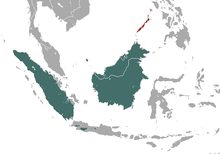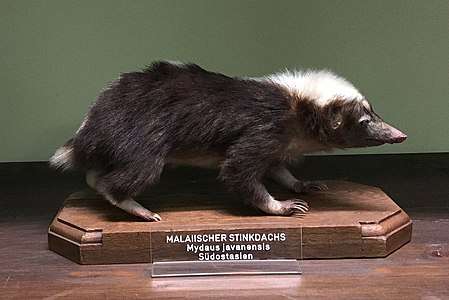Stink badger
Stink badgers (Mydaus) are a genus of the skunk family of carnivorans, the Mephitidae. They resemble the better-known members of the family Mustelidae also termed 'badgers' (which are themselves a polyphyletic group). There are only two extant species – the Palawan stink badger (M. marchei), and the Sunda stink badger or teledu (M. javanensis). They live only on the western islands of the Greater Sunda Islands: Sumatra, Java, Borneo in Indonesia and (in the case of the Palawan stink badger) on the Philippine island of Palawan; as well as many other smaller islands in the region.
| Stink badgers[1] | |
|---|---|
.jpg) | |
| Sunda stink badger (Mydaus javanensis) | |
| Scientific classification | |
| Kingdom: | Animalia |
| Phylum: | Chordata |
| Class: | Mammalia |
| Order: | Carnivora |
| Family: | Mephitidae |
| Genus: | Mydaus Cuvier, 1821[2] |
| Species | |
 | |
| Mydaus ranges | |


Stink badgers are named for their resemblance to other badgers and for the foul-smelling secretions that they expel from anal glands in self-defense (which is stronger in the Sunda species).[3]
Stink badgers were traditionally thought to be related to Eurasian badgers in the subfamily Melinae of the weasel family of carnivorans (the Mustelidae), but recent DNA analysis indicates they share a more recent common ancestor with skunks, so experts have now placed them in the skunk family[3][4] (the Mephitidae, which is the sister group of a clade composed of Mustelidae and Procyonidae, with the red panda also assigned to one of the sister clades[5]). The two existing species are different enough from each other for the Palawan stink badger to be sometimes classified in its own genus, Suillotaxus.[3]
References
- Wozencraft, W.C. (2005). "Order Carnivora". In Wilson, D.E.; Reeder, D.M (eds.). Mammal Species of the World: A Taxonomic and Geographic Reference (3rd ed.). Johns Hopkins University Press. pp. 622–623. ISBN 978-0-8018-8221-0. OCLC 62265494.
- Geoffroy-Saint-Hilaire, Étienne; Cuvier, Frédéric (1821). "Le télagon". Histoire naturelle des mammifères. 3 (27). Paris. pp. 1–2.
- Stink badgers at the Badger Pages Archived 2007-08-06 at the Wayback Machine
- Koepfli KP, Deere KA, Slater GJ, et al. (2008). "Multigene phylogeny of the Mustelidae: resolving relationships, tempo and biogeographic history of a mammalian adaptive radiation". BMC Biol. 6 (1): 4–5. doi:10.1186/1741-7007-6-10. PMC 2276185. PMID 18275614.
- Law, C. J.; Slater, G. J.; Mehta, R. S. (2018-01-01). "Lineage Diversity and Size Disparity in Musteloidea: Testing Patterns of Adaptive Radiation Using Molecular and Fossil-Based Methods". Systematic Biology. 67 (1): 127–144. doi:10.1093/sysbio/syx047. PMID 28472434.